Article
Farm Internet Tracking of PIGs
The potential for pig producers to gain better control of their production process through the use of sensors
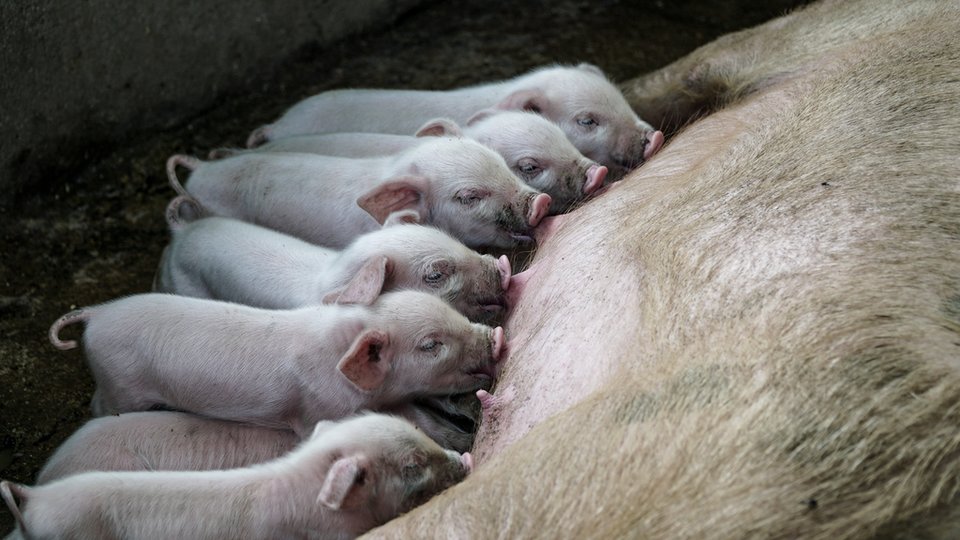
Livestock farming is competitive, and with increasing herd sizes it is ever challenging to keep the farm profitable. In pig production, producing piglets requires high skills and a lot of engagement from both farmer and staff. Farmers practice several management practices and use multiple tools to keep improving their results whilst remaining at a financially competitive level. The Interoperable Pig Health Tracking use case (UC5.6) is aimed at improving pig production in multiple ways, by for example aiming at reduced piglet mortality, decreasing the use of preventive medicine and enhance animal welfare. For this, they develop the Farm Internet Tracking of Pigs (FITPIG) IoT ear tag.
In most sectors of livestock production the role of digitalization is growing quickly, being used in the daily management of livestock. The pig production sector has not always been a frontrunner in this digitalization process. Yet, there are plenty of opportunities. Dr. Anders Herlin from the Swedish University of Agricultural Sciences elaborates: ‘’The use and adoption of digital tools in pig production has in the past not been as prominent as for example in dairy production, where many farmers have the help from sensors e.g. to detect cows in heat. But we think that there is quite some potential for pig producers to gain better control of the production process through the use of sensors.” The use case partners have identified situations where pig producers would benefit from data. They argue that the use of sensors can help support farmers’ decisions in the farrowing process, as well as help in determining when a sow is in heat and signaling health issues.
About the FITPIG sensor
The FITPIG sensor is integrated in a commercial off-the-shelf identification ear tag. A 3d accelerometer is integrated in the FITPIG sensor to allow monitoring of the activity level of animals. Next to this, a technology known as “Photoplethysmography” (PPG) is used to monitor the heart rate. For this, an optical (infrared) sensor is integrated in the ear tag. This sensor measures the dilation of the blood vessels when a heartbeat pushes the blood in the arteries. This technology is not new, as Stephan Dasen from CSEM explains: “PPG technology is currently widely used for humans in a hospital environment through pulse oximeters to monitor heart rate and blood oxygenation, as well as in leisure activities such as the heart rate monitoring on smart watches.” CSEM already worked on raising PPG technology in human applications to the next level, allowing the monitoring of parameters such as blood pressure and stress. Through this use case, they are now also entering the field of animal production by monitoring pigs’ heart rates.
The data generated by the FITPIG ear tag is collected through a gateway (Smart Spot) using Bluetooth Low Energy (BLE). The gateway sends data to the cloud for processing via WiFi, LoRa and GPRS. Ana Peñaranda from HOP Ubiquitous S.L. elaborates: “Included with the gateway is a sensor that measures harmful air contaminants within the pig stable such as dust and ammonia, and also some other gases.’’
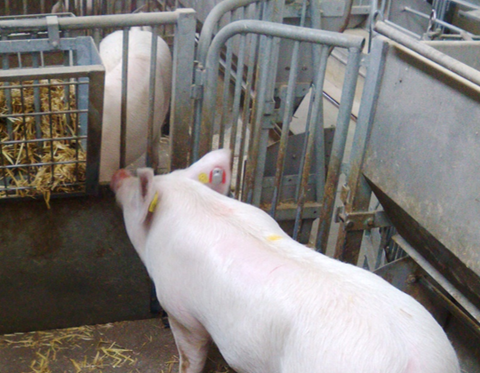

Pigs with FITPIG ear sensors. The ear tags are equipped with a heart rate sensor and an accelerometer (photo Stephan Dasen)
The data from the ear tag sensors and from environmental conditions sensors gets combined, feeding a series of artificial intelligence algorithms. These algorithms analyze the information, generating behavior patterns for sows and for their conditions. If at any time, these patterns are modified, notifications are generated for the farmers who receive them in their mobile app from which they can access all the information of their farm easily. Ana Bugueiro from Digitanimal says “We are already applying this technology and algorithms in other livestock sectors such as beef, sheep, etc.”. Through the Interoperable Pig Health Tracking use case the technology is now also being tested in pig production.
Some of the main benefits and applications of the use of IoT ear tag sensors in pig production are:
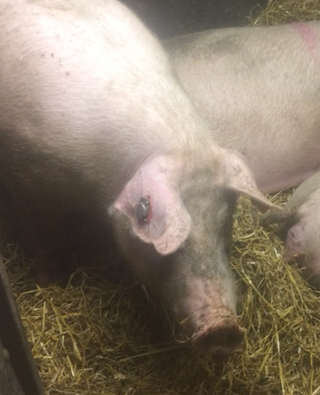
Predicting and monitoring farrowing
Farrowing is the most crucial part in pig production as the new pigs are produced. In modern pig production, sows are managed in group-wise in all in – all out systems, where sows are moved into a cleaned farrowing unit approximately one week prior to the expected date of farrowing. As there are some variations in the breeding dates and the length of pregnancy can vary by a couple of days. In modern production systems, all sows in a synchronized managed group and are expected to farrow within a week. Before the farrowing the sows starts “nest building” by collecting material to build the nest for the farrowing. The nest building starts about 24 hours before farrowing and peaks about 12-6 h before the farrowing starts. As parturition approaches, the sows calms down. The sow lies laterally and is generally immobile during the parturition.
The FITPIG system, using data from the accelerometer, tells the farmer when each sow has started nest building and for how long it has been going on. When nest building becomes less intensive, farrowing approaches. At present there is no clear indicator for the onset of piglet delivery from the accelerometers in the ear tag other than the ending of the highly active nest-building period. However, the expectation is that through the combination of unique individual and group/herd nest building data and through video filming of farrowing sows the use case partners will be able to refine their algorithms in order to increase their ability to predict and recognize the moment that farrowing commences. This would offer farmers 24/7 data on when pigs will farrow, which pigs have started farrowing, and how long farrowing has been going on. The farmer can proactively monitor and control whether farrowing is going well, and if necessary act upon this (farrowing that takes longer than 400 minutes can have health and fertility consequences for the sow).
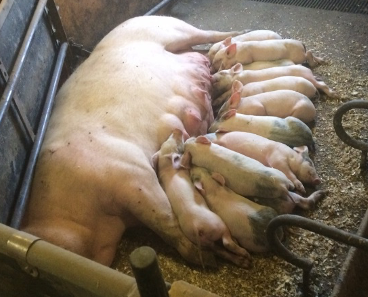
Monitoring pig health and warning farmers when health issues occur
When animals have an infectious disease, the normal reaction is fever. The PPG sensors in FITPIG ear tags capture the heart rate of the animal when it is resting. An elevated heart rate at rest is a clear sign of fever. This can help in recognizing health issues. Common examples of health issues in the farrowing process are metritis and mastitis, both are accompanied by a fever. A third disease is agalactia, where the sow gives no milk. At the moment the use case members work with ‘’fever alerts’’ and ‘’suspicious’’ classifications to inform farmers on deviations that might suggest health issues. The next step will be to refine data, using algorithms to be better able to determine which condition a sow has. It would be beneficial to quickly distinguish between conditions, as different treatments are required. Metritis and mastitis are treated with antibiotics but agalactia is treated by oxytocin.
Next to the PPG sensors the accelerometer in the FITPIG ear tag might also help detect and classify health issues, as it enables a farmer to detect sows that show deviating activity patterns as compared to the rest of the sows in the same group.
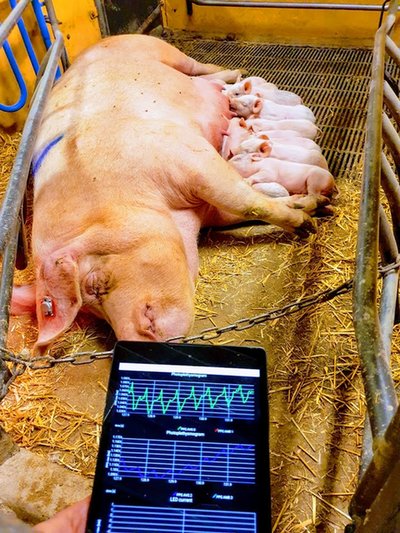
Detection of sows in heat and detection of successful insemination
When sows are removed from piglets, this is called weaning, sows come into oestrus (heat) within a few days to a week. The indicators for this are higher levels of activity and possibly a somewhat raised body temperature. There is some variation in the onset of estrus. Thus, accelerometers and PPG sensors can help in detecting sows in heat. This could help farmers cut time spent on sows that are not in heat during the insemination process. Furthermore, it can help in the planning of production and selection of sows for breeding. Lastly, the sensors enable the farmer to find out whether a sow did or did not become pregnant about 3 weeks after insemination through monitoring body temperature and activity during the next heat cycle.